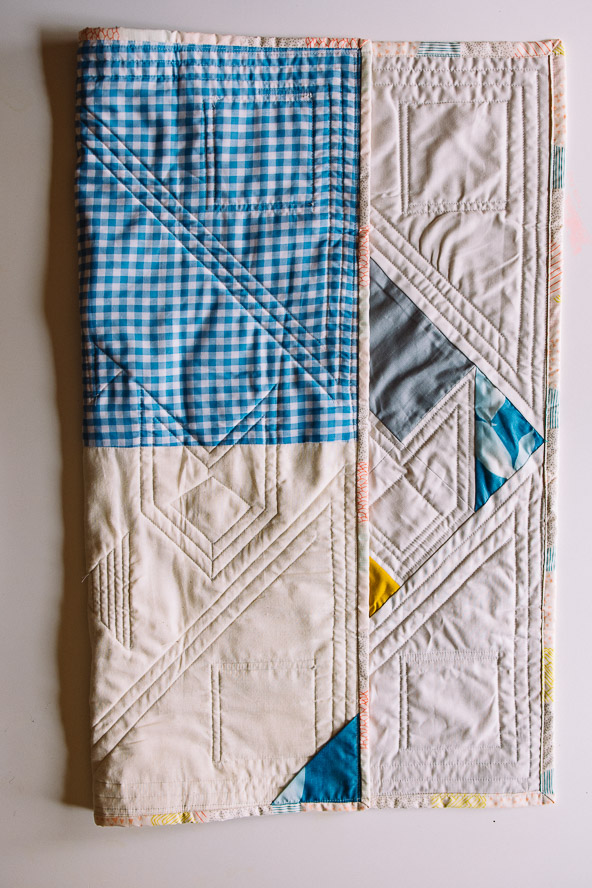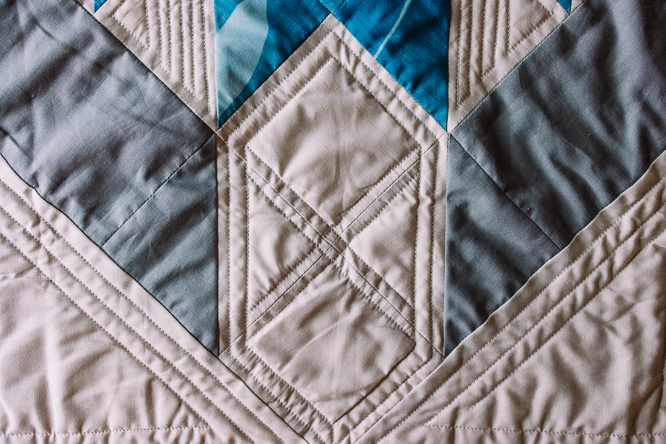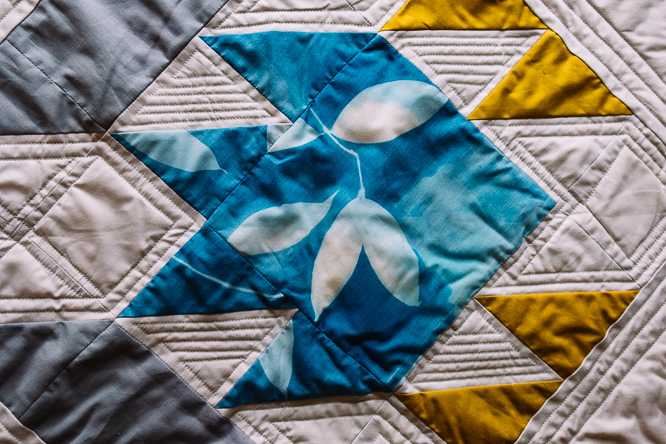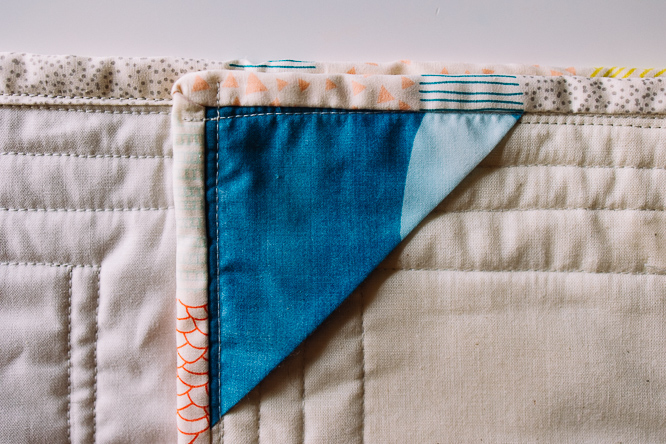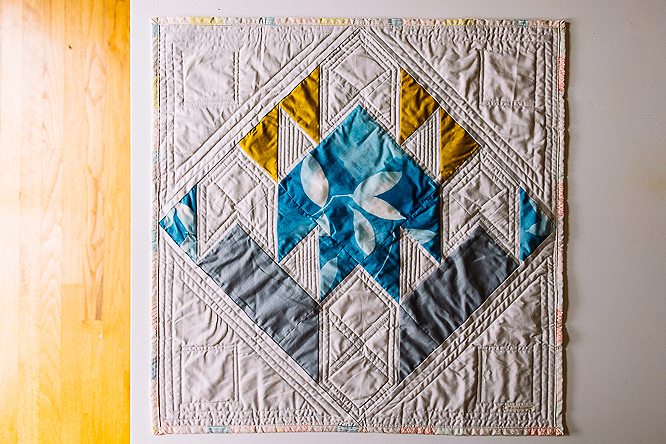
Tackle a classic quilt block by making a gorgeous wall hanging fit for a mountainside lodge. Learn how to make a bear paw quilt block with this easy quilting project. Finishing at a 28” square, this quilted wall hanging is made in modern shades of slate gray, cobalt blue and citron, and can be made using fat quarters. Whether displayed on your wall or above your mantel, this rustic chic wall hanging is an instant attention-grabber.
Skill Level: Easy
Finished Dimensions: 28″ square wall hanging
Seam Allowances: 1/4″ patchwork
Materials:
- Fabrics for wall hanging:
- Blue feature – 1 fat quarter or 1/2 yard
- Gray – 1 fat quarter or 1/4 yard
- Yellow – 1 fat quarter or 1/4 yard
- Background – 1/2 yard
- Backing – 1 yard
- Binding – 1/3 yard
- Fabrics for baby quilt/throw quilt (quilt diagram located at bottom of page):
- Blue – 4 fat quarters or 1 yard
- Gray – 1 fat quarter or 1/4 yard
- Yellow – 1 fat quarter or 1/4 yard
- Background – 2 yards
- Backing – 4 1/2 yards
- Binding – 2/3 yard
- PDF Layouts – These are located at the bottom of the page. Please see printing instructions below.
Special Notions:
- Walking foot
- Rotary cutter
- Grid mat
- Acrylic ruler
ABBREVIATIONS:
- “RST” means Right Sides of fabric Together
- “WOF” means Width of Fabric
PRINTING INSTRUCTIONS:
To download the PDF layouts, click on the download button at the bottom of the page. We recommend opening your download using Adobe Acrobat.
Instructions:
CUTTING:
- Line up selvages and press all fabrics to remove any creasing or wrinkles.
- Neaten and trim up the cut edges along the WOF (Width of Fabric) with a rotary cutter, ruler and cutting mat as required to create an even edge.
- From the newly trimmed edge, use the cutting mat grid and acrylic ruler to cut:
- Blue Feature (paw) fabric: 1- 8 1/2″ square, 3- 5″ squares
- Gray fabric: 2- 8 1/2″ x 4 1/2″ rectangles, 1- 5″ square
- Yellow fabric: 2- 5″ squares
- Background fabric: 6- 5″ squares, 5- 4 1/2″ squares, 2- 15″ squares
- Sub-cut the 15″ Background fabric square across one diagonal to create 4 triangles to frame the interior Bear Paw on Point.
PIECING THE “CLAW” BLOCKS:
- To create the 2-at-a-time half-square triangles or “claws,” pair one 5″ background square with each 5″ colored squares RST.
- Using a ruler and pencil, draw a diagonal line from one corner to the opposite corner on each background square. Pin in place.
- Sew 1/4″ down each side of the diagonal line. Repeat for all 5″ pairs. See Figure 1.
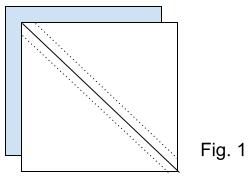
- Cut each 5″ square along the diagonal line and press open to the darker fabric. Trim to a neat 4 1/2″ square using the diagonal line on the grid ruler to remove excess from all sides as necessary. Repeat for all pairs to create: 12 half-square triangle units for the wall hanging or 48 units for the baby quilt.
LAYOUT AND BLOCK ASSEMBLY:
- Arrange completed 4 1/2″ “claw” blocks, 4 1/2″ background squares, 8 1/2″ x 4 1/2″ rectangles and 8 1/2″ “paw” square into rows as shown in Figure 2.
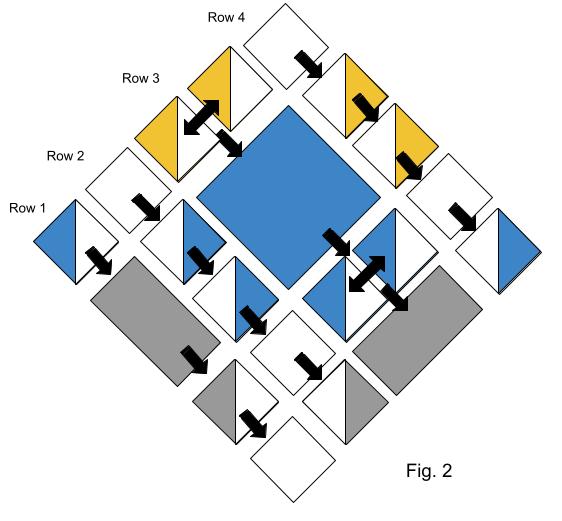
- Begin by sewing all blocks by rows as shown, RST. Press seams flat or to darker sides of fabric upon completing the row.
- For row #3, first, sew the two yellow and two blue “claw” units together into pairs before sewing them to “paw” square.
- Assemble all rows, then begin joining rows to complete the block. Press all seams flat.
- Trim the outer perimeter of the entire block to neaten to a square 20″.
- Repeat Steps 1-4 as necessary to make the remaining Baby Quilt blocks. Refer to the completed layout for the Wall Hanging or Baby Quilt for additional details.
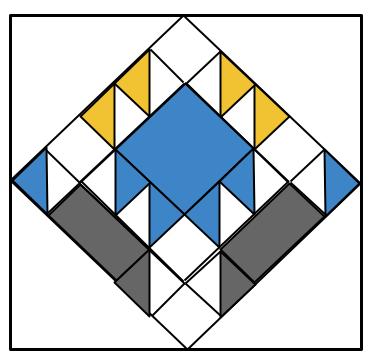
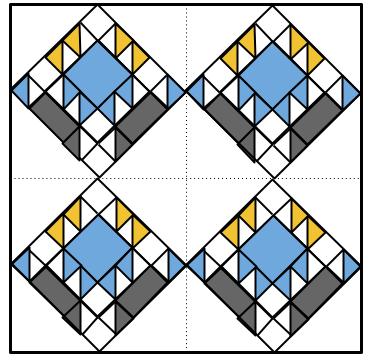
SETTING BLOCK(S) ON POINT:
- Fold each 15″ background triangle in half with the points on the longest side of the triangle touching and iron for a central crease. Fold or measure for the central line of the 20″ Bear Paw block and press to create a crease marking the center of all four sides.
- Line up the crease of the triangle with the crease of the central unit and pin in place. Repeat for the opposite side and sew each in place. Triangle tips will hang approximately 1/2″ over the edge of the central block.
- Repeat sewing the remaining two opposite triangles in place to complete the square.
- Press the entire block flat and trim to a neat 28″ completed wall hanging. See Figure 3.
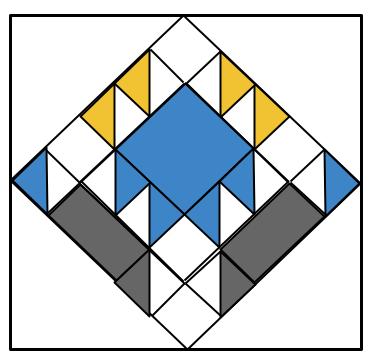
QUILTING AND FINISHING:
- Cut a strip of batting and backing approximately 2-3″ wider and longer on all sides than your finished quilt top.
- Assemble the quilt sandwich for the quilt by laying out the backing (right side down), batting in the center and quilt on top, right side up. Baste and quilt as desired and trim edges. The sample quilt has been quilted in a grid pattern following the seam lines of the piecing.
- Prepare the binding by cutting 2 1/2″ by WOF strips of fabric and attaching all strips together on the diagonal. Press strips wrong sides together in half lengthwise along the entire length of the binding to complete.
- For the Wall Hanging, insert a loop of fabric across the top length of the block or two pockets of fabric in each corner for hanging.
- Attach binding to the quilt sandwich by lining up all raw edges, mitering the corners as you go.
- To miter corners, sew into the corner stopping a 1/4″ from the end, backstitch, and remove the quilt from the sewing machine.
- With the quilt laying flat, fold the binding up and away from the quilt, making the binding straight with the unsewn side. (Fig. 4)
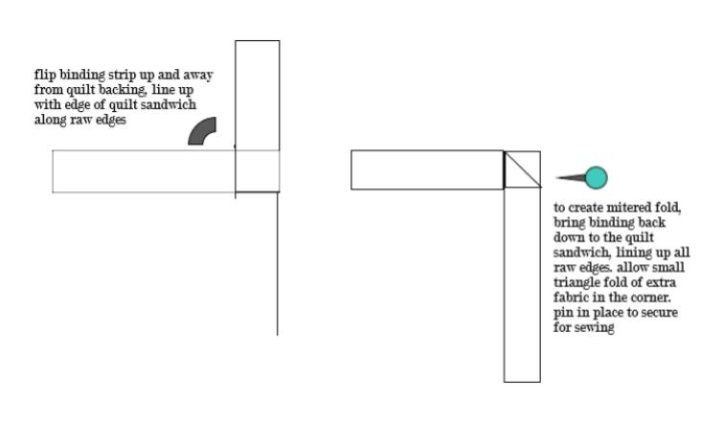
- Fold the binding down to the sewn side, leaving a diagonal fold on the underside of the binding and pin fold in place. (Fig. 4)
- Place the quilt back into the sewing machine and sew down the fold and continue on sewing binding.
- Make a miter at each corner, adjusting the amount of fold as necessary.
- Join the ends of the binding together where they meet and attach to the quilt sandwich.
- Press and fold the binding over to the opposite side of the quilt to finish. Tuck the mitered corner flat, pinning into place as necessary.
- Finish the binding with your preferred method, either by hand stitching in place or machine stitching.

